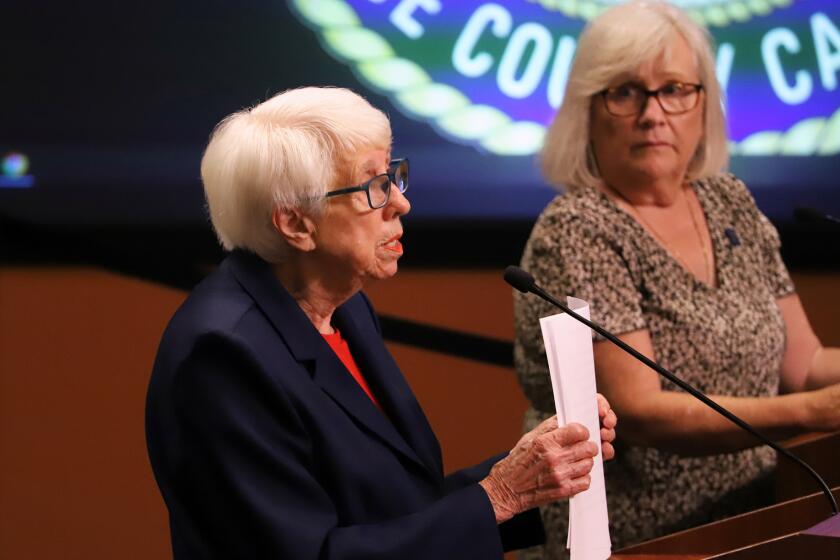Newport wastewater rates heading up in January
Newport Beach sewer rates will go up in January.
The City Council approved a final reading Tuesday night on a 5-1 vote, with Councilman Jeff Herdman absent and Mayor Kevin Muldoon dissenting, to finalize the city’s first sewer rate increase since 2006. The typical residential sewer bill will climb by $2.36 per month starting Jan. 1 and continue to climb incrementally through 2022.
For the record:
10:06 a.m. April 25, 2024The original version of this article stated incorrectly that Tuesday’s council vote on the sewer rate increase was 6-1. It actually was 5-1, with Councilman Jeff Herdman absent.
The council initially agreed to the rate hike Sept. 12 on a 6-1 vote, with Muldoon voting no. He said at the time that rates should be increased only as a last resort.
Most residential wastewater customers currently pay a fixed charge of $4.50 per month and a use charge of 35 cents per hundred cubic feet of water used. A hundred cubic feet, or HCF, equals 748 gallons.
The new rate structure will raise most residential fixed fees to $6.46 per month, with the per-HCF rate increasing to 38 cents.
For the typical residential customer with average wastewater use of a little less than 12 HCF per month, the new structure will increase the total monthly bill next year from $8.63 to $10.99.
Rates will continue to rise over the subsequent four years, peaking in 2022 at $8.55 in fixed charges and 54 cents per HCF.
Clerk’s office adding position to handle records requests
Newport Beach will add a position to the city clerk’s office to keep up with the growing number of public records requests.
The city will convert its three-quarter-time records specialist to full time and convert a temporary part-time “department assistant” position to permanent.
City Clerk Leilani Brown said the demand for records is growing locally and around the state and that nearby cities such as Irvine, Costa Mesa, Huntington Beach and Oceanside have hired as many as 10 staff members solely to manage records and process public requests. In 2014, Costa Mesa hired an assistant city clerk to ease the workload on its clerk’s office.
Newport Beach, however, has only the one part-time records specialist dedicated to processing requests, with other staff members helping out when time and workloads permit. The clerk’s office currently has 6.7 full-time-equivalent employees.
“The demands are simply outstripping my office’s resources,” Brown said.
Brown said the staffing move is cost-neutral as it absorbs funding for some temporary positions that were set to expire this year. The new half-time job will pay about $23,400 per year.
The city clerk’s office is tasked with inventory, retention, maintenance and dissemination of public records, along with administering local elections. In 2015, the office directly fielded 248 records requests while assisting other city departments with about 600. Last year, those numbers grew to 281 and 700, respectively. This year, Brown said, she expects her office to receive 500 requests, while other offices could get 1,000.
Last week alone, she said, her office received more than 40 requests.
A records request goes through several steps between receipt and delivery, and if the city misses any steps, it can result in litigation “similar to the lawsuit a few years ago which cost the city hundreds of thousands of dollars in attorneys’ fees,” Brown said, referring to a 2014 case of a resident who encountered difficulty when seeking documents related to the city-sponsored nonprofit Newport Beach Sister City Assn.
More input sought on mooring changes
The council postponed a vote on updating proposed technical requirements for mooring hardware in Newport Harbor so the city can gather more public input.
Proposed changes for mooring permit holders include increasing their minimum mooring weights by 20% to keep boats from drifting and colliding during strong winds; requiring a shift from ring-style buoys to tube-style buoys for offshore moorings; allowing single-buoy sand-line moorings, like those commonly used on Catalina Island; and requiring that thicker chains be used in 20- to 30-foot moorings.
The council will revisit the issue Nov. 14.
Twitter: @Daily_PilotHD
All the latest on Orange County from Orange County.
Get our free TimesOC newsletter.
You may occasionally receive promotional content from the Daily Pilot.




